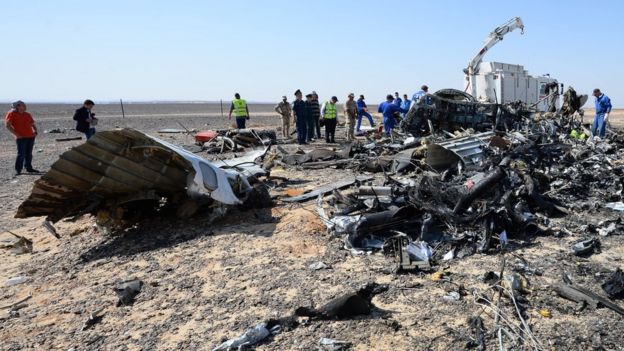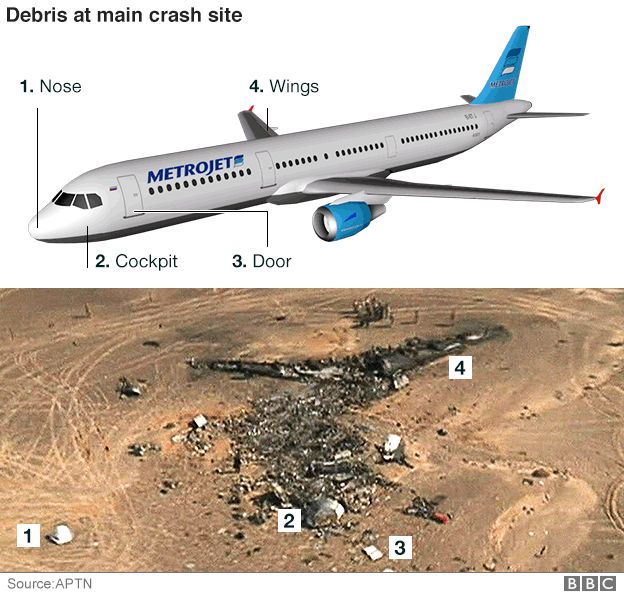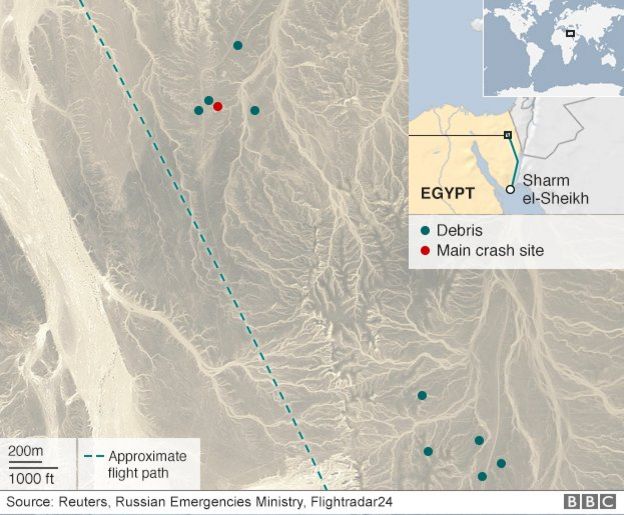
Egyptian President Abdul Fattah al-Sisi has described claims that militants linked to Islamic State brought down a Russian airliner as "propaganda".
He told the BBC that it was too early to say what had caused the crash.
The Airbus 321 is thought to have broken up in mid-air over the Sinai peninsula on Saturday, killing all 224 people on board.
On Monday, the airline Kogalymavia blamed "external influence" for the crash.
But the head of Russia's Federal Aviation Agency, Aleksandr Neradko, told Russian TV that such talk was premature and "not based on any proper facts".
President Sisi also warned against jumping to conclusions. "All those interested in the matter are welcome to participate in the investigation," he told the BBC ahead of a visit to the UK.
"When there is propaganda that it crashed because of Isis (IS), this is one way to damage the stability and security of Egypt and the image of Egypt. Believe me, the situation in Sinai - especially in this limited area - is under our full control."
The US director of national intelligence, James Clapper, said there was no "direct evidence of any terrorist involvement yet" adding: "It's unlikely, but I wouldn't rule it out."
- Four theories about the crash
- What we know so far
- Who were the victims?
- KGL9268 crash: How it unfolded
- Russian media brood over cause of air crash
Militants launched an insurgency in the Sinai following the fall of President Hosni Mubarak in 2011. They stepped their attacks after the military overthrew Islamist President Mohammed Morsi in mid-2013.
A year ago the insurgents renamed their movement Sinai Province and pledged alliance to Islamic State. Hundreds of police and soldiers have been killed.
After the crash Sinai Province issued a written statement and an audio message saying that it brought down the passenger jet.
However, experts doubt it possesses the weapons capable of bringing down an airliner.
The Airbus 321 had been carrying 217 passengers, including 25 children, and seven crew members. Most of those on board were Russians.
It crashed 23 minutes after taking off from the Egyptian Red Sea resort of Sharm el-Sheikh en route to the Russian city of St Petersburg.
The plane's flight recorders have been found and sent for analysis.
Debris was spread across a wide area of Sinai, officials said.
On Monday, the deputy director of Kogalymavia - which has just renamed itself Metrojet - ruled out a technical fault or pilot error.

"The only [explanation] for the plane to have been destroyed in mid-air can be specific impact, purely mechanical, physical influence on the aircraft," Alexander Smirnov said.
"There is no such combination of failures of systems which could have led to the plane disintegrating in the air," he added.
He said the plane lost speed and started descending rapidly, and the crew made no attempt to get in contact and report about the situation on board.
The US broadcaster CBS News reported that a US satellite had detected a "heat flash" over the Sinai at the time of the crash.
It said the data was still being analysed and that although the flash could have been caused by a bomb, a fuel tank or engine explosion was also possible.
It is believed to be Russia's worst ever air disaster. The bodies of most those killed have been flown back to St Petersburg and identification is under way.

Timeline: the course of flight KGL9268
05:58 Egyptian time (03:58 GMT): Flight leaves Sharm el-Sheikh, a statementfrom the Egyptian cabinet says
06:14 Egyptian time (04:14 GMT): Plane fails to make scheduled contact with air traffic control based in Larnaca, Cyprus, according to Sergei Izdolsky, an official with Russia's air transport agency
06:17 Egyptian time, approx (04:17 GMT): Plane comes down over the Sinai peninsula, according to Airbus
11:12 Egyptian time (09:12 GMT): Flight had been due to land in St Petersburg's Pulkovo airport
No comments:
Post a Comment